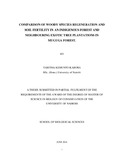| dc.description.abstract | The regeneration of understory woody vegetation in different plantation forests was
investigated in Muguga Forest Station. Species composition, vegetation structure, understory
woody species regenerates structure and soil physiochemical characteristic were assessed in
five different forest types, the Indigenous forest, Cypress plantation, Eucalyptus plantation,
Mixed Acacia-Eucalyptus plantation and Pine plantation. The Eucalyptus, Cypress, Pine and
mixed Acacia-Eucalyptus plantations had significantly higher densities of mature trees as
compared to Gachuthi indigenous forest (F5, 96 = 56.43, p<0.05). The mean densities of
immature woody species were only significantly higher in Gachuthi than in the Pine
plantation (F5, 298 = 2.45, p<0.05) but mean densities for saplings and seedlings did not vary
significantly (p>0.05) among the different forest types. Foliar cover and woody species
abundance of immature trees showed a significant positive correlation (r = 0.362) in Gachuthi
(t0.05 (2), 34 = 2.26, p<0.05) and a significant negative correlation (r = -0.414) in the mixed
Acacia-Eucalyptus plantation (t0.05 (2), 34 = 2.65, p<0.05). The sapling and seedling abundance
had no significant correlation to foliar cover (p>0.05) in the different forest types. Soils in the
forests studied were classified as clay soils with no significant differences in pH, soil nitrates
and organic carbon (p>0.05) among the different forest types. The woody species abundance
of immature trees and soil nitrates showed significantly negative correlation in Gachuthi (t0.05
(2), 34 = 2.39, p<0.05) while there were no significant correlations in the other forest types. Soil
pH, nitrates and organic carbon showed significant (p<0.05) negative correlations to sapling
abundance in Gachuthi and significant (p<0.05) positive correlations to sapling abundance in
the Pine plantation. Soil pH and seedling abundance showed significant negative correlation
(r= -0.35) in the Cypress plantation (t0.05 (2), 34 = 2.18, p<0.05) whereas it was not significant
among other forest types. In this study, the significantly low percentage foliar cover and
higher soil nitrates content in the indigenous forest seemed to favour the survival of seedlings
to the immature age class. | en_US |

